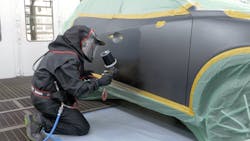Complex automotive finishes are not tricky to repair with due care
Whether it’s a warm, retina-searing translucent and saturated finish, such as Mazda’s 46V Soul Red, or a cool “carved-from-metal” look — as found in Mazda’s 46G Machine Gray or Mercedes’ 047 Alubeam — exciting finishes such as these and more are in today’s showrooms because of advancements in automotive coatings.
These modern finishes’ dispersions keep fine pigments evenly suspended throughout several translucent layers, said Dan Benton, refinish color marketing manager for Axalta Coating Systems.
“Light-vehicle OEMs are taking advantage of these innovations in automotive coatings and application processing, which affects appearance and allows for more saturated hues,” he said. “The intention is to use the color capabilities to further enhance the design process to grow sales and market share.”
With an estimated 80 percent of the vehicle color population being non-chromatic — grays, whites, and silvers — the remaining 20 percent tends to fall in the “complex finishes” category, said Chelsey Clemsen, product manager of vehicle refinish for Sherwin-Williams Automotive Finishes.
“OEMs use these more sophisticated, luxurious and, yes, “complex,” colors, as a point of differentiation, marketing vehicles to prospective buyers looking for the luxury look without the price tag,” she said.
The different color appearances are made possible by using complex multilayered finishes, said Chris Holly, technical manager, color library, for BASF Automotive Refinish.
“In the case of a red tinted clear or a red tri-coat application, a richer, more chromatic color can be achieved than can be with a standard basecoat/clearcoat approach,” he said. “Similarly, with the Mazda 46G color, a more liquid metal appearance is feasible with a multilayer approach.”
Refinishing requires care, but it’s not difficult, as long as proper steps are followed
Such finishes require extra steps at the assembly plant, so it’s logical that refinish procedures must be followed closely to replicate them — and usually with extra steps and costs involved. But the refinish manufacturers ABRN spoke to — Axalta, BASF, PPG, and Sherwin-Williams — said that although these vivid or “liquid-metal” colors require unique pigments and application processes to achieve a match, they really are not that tricky.
It makes sense that if a factory uses a complex process at the assembly plant to produce a vivid or carved-from-metal finish, the refinish process will not be able to take shortcuts to replicate it. Most paint company representatives responded that, where possible for simplicity, they offer a two-stage formula when an excellent match is possible. But in the case where a company offers both a two-stage and a three-stage formula, the two-stage formula sometimes trades color match accuracy for its simplicity.
“Depending on the color, two-stage solutions may be feasible for certain job requirements,” BASF’s Holly said. “Some easier-to-achieve colors can be matched close enough as a two-stage to use for a blend-in or where the color does not need to be right on due to part spacing or geometries.”
Opinions differed on whether pearl tri-coats, which have been offered by OEMs for decades, are easier to apply than translucent, candy-type finishes.
“This always depends on the color, but as a rule, neither is harder than the other,” Axalta’s Benton said. “The challenge is having the right pigment in the refinish toners and controlling the translucent mid-coat layer during application.”
Sherwin-Williams’ Clemsen offered a dissenting opinion. Candy-type finishes can often be trickier than pearl tri-coats, she said.
“For candy-type finishes, we recommend creating a step-down panel to determine the number of mid-coat layers required to achieve the correct color match,” she said. “The step-down panel is critical to ensuring optimal color match, as is overlap.”
BASF’s Holly agreed with Clemsen.
“Color match is typically a little more straight-forward for the pearl tri-coats, as the mid-coat usually contains only pearl,” he said. “With candy-type colors, there can be different color toners involved to get the desired color. As for application, both color types have a translucent layer that needs to be applied evenly and to the proper thickness to achieve proper color with good appearance.”
Consult technical data sheets for guidance
Each company’s process may differ, but company representatives stressed that painters who consult their technical data sheets (sometimes known as a “product data sheet”) and other technical resources readily adapt to the different process.
“Always start with the product data sheet and check for additional process documents for the particular color you are working on,” said Robert Smith, PPG application specialist. “We have process documents for these special finishes like Mazda 46G, Mercedes Alubeam, etc. Other resources are videos that deal with these types of finishes and some specific paint codes, such as Lexus 8Y0, Mazda 46V, Mazda 46G, and low-gloss finishes. PPG also offers tech tips on its training website.”
All paint manufacturers contacted by ABRN recommend a wet bed of blending additive or colorless basecoat to provide a sand-scratch-free, uniform surface within the blend area.
“For proper orientation, a wet bed is always recommended to aid in blending aluminum flakes,” Benton said. “Blending into a wet film, versus a dry sanded film, gives a smoother transition and seamless repair.” He added that it’s imperative to use the proper grit of sandpaper that results in a “superfine” surface so the aluminum lays properly.
Some paint manufacturers recommend a cross-coat, although a drop-coat/control coat technique, as used on traditional high-metallic colors, is to be avoided. As an example, PPG recommends applying three to four wet coats of reduced 46G basecoat using an X-pattern cross-coat technique at 90 percent overlap. This helps align the leafing aluminum in a horizontal position, and this technique must be used in each coat. Control coats, Smith said, can cause an undesirable coarse, sparkly appearance.
“The most important thing to do with any of these ultra-fine metallics is to spray with proper distance and overlap in the wet to eliminate excessive orientation coats. This will help the metallic lay down properly in the beginning and keep additional sparkle from being created in the basecoat,” Benton said.
How to prevent some common application errors
As with all refinishing processes, following data sheets and any additional paint company guidance allows most painters to quickly adapt to a process that may be new to them. “We find that painters often miss, either intentionally or unintentionally, the extra steps critical to achieving color success,” Sherwin-Williams’ Clemsen said. “Colors that fall in the complex finishes category require the painter to move away from the traditional application process and follow the recommended guidelines, which cover everything from prep to spray gun selection.”
Mazda 46G is a finish that uses a black groundcoat, which, depending on paint manufacturer, may be either a sealer or a basecoat, followed by a fine leafing aluminum mid-coat and clearcoat. This type of finish requires a surface smooth enough for the mid-coat, which contains fine effect pigment, to lay flat, Axalta’s Benton pointed out.
BASF’s Holly agreed. “The real difference is that three stage finishes have a translucent layer involved,” he said. “The evenness and thickness of this layer is very important for getting the right appearance and color. These concerns are not nearly as critical for two-stage colors.”
It is possible for the mid-coat for 46G, as is the case with all ultra-fine aluminum effect coats, to mottle if it is not applied with the correct distance and overlap, Benton said, so it’s critical to select the reducer appropriate for the booth temperature to aid application.
The spray gun setup recommended to help prevent mottling when spraying 46G varies for each paint manufacturer. BASF is one that does not recommend a fluid tip different from what the painter uses for other basecoats, although it does advise applying two or three effect coats. Sherwin-Williams recommends a smaller fluid tip.
Smith said PPG recommends using a 1.0 to 1.1 fluid tip, with the flow reduced by turning the fluid knob one to one-and-a-half turns out from closed, which will help the painter achieve the correct appearance of the aluminum.
“Mazda 46G will mottle if it’s applied too wet,” he said. “Conversely, if it’s applied too dry, the aluminum will appear too large. The large appearance is noticeable in bright sunlight (it will be too sparkly.)”
Depending on which basecoat technology is used, Benton said, Axalta recommends either using a smaller fluid tip or reducing fluid flow to allow the aluminum flake to lay down and appear finer.
The Mazda 46G and similar finishes require what is variously known as a letdown panel, ladder panel, or dropdown panel to be prepared prior to refinishing. For painters accustomed to spraying white tri-coat pearl finishes, this will be a familiar requirement, which shows what the proper number of coats, sprayed as will be the vehicle, to achieve a proper match.
Additionally, Axalta recommends using check-hide stickers on the masking adjacent to the repair area to ensure proper coverage.
All paint companies reported equal success in matching such complex finishes in their solvent-borne or waterborne chemistries, although whether the formula is available in a two-stage or only a tri-coat may depend on its chemistry.
It varies among paint companies whether or not 46G uses a limited-use tint/toner that is not included as standard but can be installed on the mixing bank. Some offer factory-pack mixed color for certain colors, which may be an advantage if it’s a very expensive toner that may only be used once.
“For these colors, the toners needed are commercialized, so there is no need for a factory-pack approach,” BASF’s Holly said. “Occasionally, when a new complex color like this is developed, it may require a toner that is not yet commercialized, in which case a factory-pack approach could be best.”
So what’s on the horizon for the colors coming to tomorrow’s showrooms?
“Vehicle manufacturers are busy creating new complex finishes,” Sherwin-Williams’ Clemsen said. “Trends point to increased four-stage colors and high chroma colors in the red and blue families with a deep and wet appearance.”
Whatever technology finds its way to future vehicle finishes, automotive refinish manufacturers will tackle the challenge of helping auto body repairers repair and match them.
About the Author
Jay Sicht
Editor-in-Chief, FenderBender and ABRN
Jay Sicht is editor-in-chief of FenderBender and ABRN. He has worked in the automotive aftermarket for more than 29 years, including in a number of sales and technical support roles in paint/parts distribution and service/repair. He has a bachelor's degree in journalism from the University of Central Missouri with a minor in aviation, and as a writer and editor, he has covered all segments of the automotive aftermarket for more than 20 of those years, including formerly serving as editor-in-chief of Motor Age and Aftermarket Business World. Connect with him on LinkedIn.
Don't miss Jay's next article or podcast. Sign up for FenderBender Today's Collision Repair News and ABRN eNews here.

